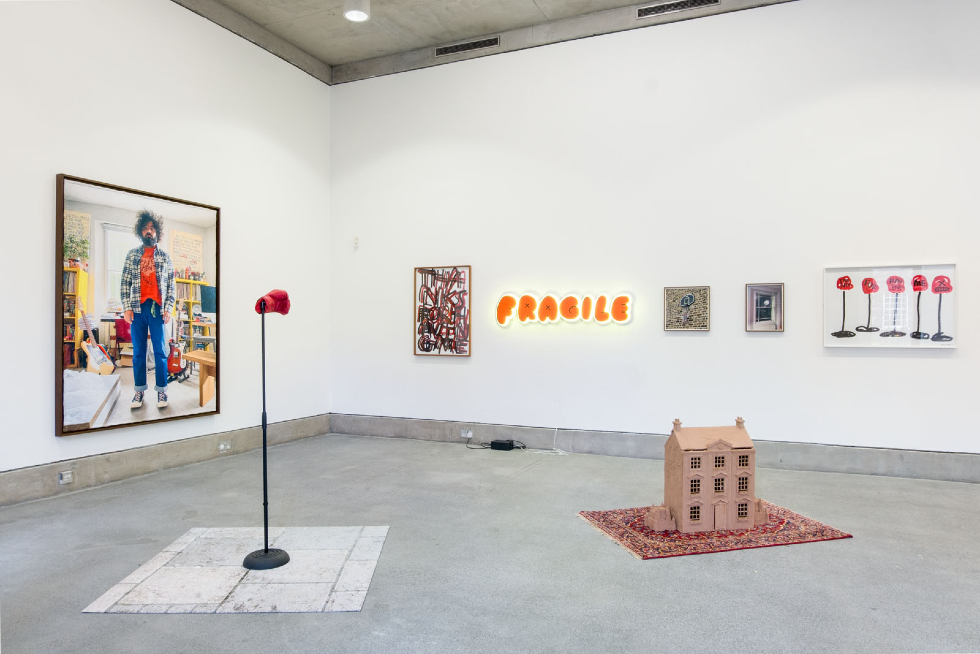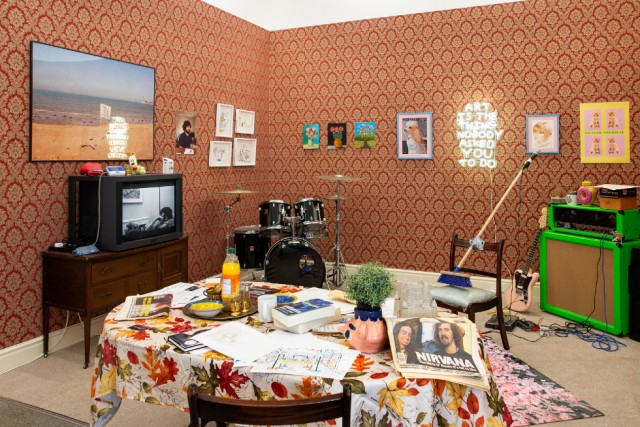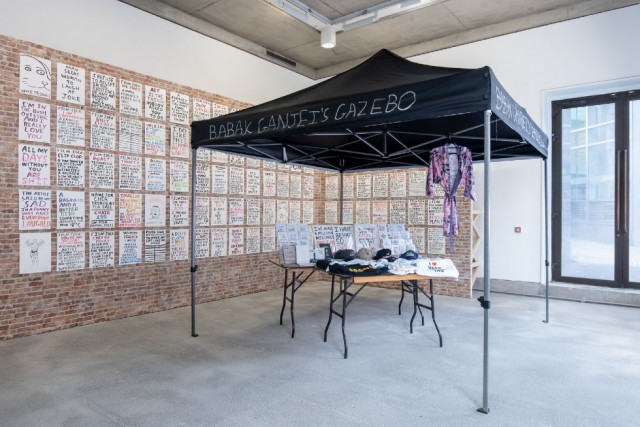Portrait of the Artist as a
Middle-Aged Man
Babak Ganjei @ Bluecoat – Reviewed

Art can be challenging, addressing, as it should, the realities of life. But both wry and searingly honest, Bluecoat show Babak Ganjei: Thanks for Having Me is, refreshingly, a laugh out loud hit, finds Mike Pinnington…
When was the last time you were given permission – and cause – to laugh, really laugh out loud, in an art gallery setting? I ask the question, not to criticise or call into question the myriad ‘urgent’, ‘important’ and ‘challenging’ exhibitions that address the difficult times in which we live. Rather, it is what, in a roundabout way, I asked myself having seen Bluecoat’s current ground floor exhibition, Babak Ganjei’s Thanks for Having Me.
Indeed, irreverence rules in this exhibition, the artist’s largest solo show to date. Through text, neon, installation, portraiture and film, using a framework of, by turn, absurdist, silly and self-deprecating humour (more of which later), Ganjei has chosen to reflect on life, a collection of lives really, thus far.

LET’S GET THE BAND BACK TOGETHER!
In the first space, given the name ‘demos’, we find him contemplating, dewy-eyed, his formative years. It is appropriately titled, in that it is a recreation of a living room as recording studio (above), which he shared with friend Matt Tong, and where the pair dipped their toes into the waters of creative endeavours to follow.
Strewn around are the accoutrements of not quite adulthood – copies of The Face, and the NME from the early 1990s (crucial publications of the day); fan art, capturing the likenesses of Sonic Youth and Iggy Pop, among others.
Framed on the wall is a present day letter from Ganjei to his friend Matt, in which the artist admits to pre-exhibition nerves; that he’s retreated back to the days this room captures, sitting on the bed and playing guitar in the dark, writing songs: “the joy of creating something with no expectation placed upon it.”
CHAPTER ONE 1978
Moving on, we find Ganjei face to face with his ‘difficult second album’; difficult, perhaps, because here we have a greater sense of his tussling with life, with having come of age, with what it – and he – should represent. There is yet more time travel: another text work finds Ganjei recounting (presumably not from memory) the circumstances of his birth: “I was born in the hospital, I was crying because I didn’t know what the hell was going on… There were three channels on TV.”
Nearby is a life-size contemporaneous image of the artist (top). He is wearing a bemused yet endearing ‘who am I and how did I get here?’ look. A pair of guitars, and his Pavement t-shirt keep him in touch with the musician and fan of his younger days while, over each shoulder, text works remind us of his present day reality. Another, different kind of self-portrait awaits, but one no less honest for that: books stacked to the artist’s height, made up of his to be read pile. There are names here we might recognise as important: Berger, Benjamin, Sontag, Sartre, but punctuating these are tomes by the likes of Arnold Schwarzenegger, Pamela Anderson and David Hasselhoff.
Like the collaged picture of Ganjei himself that is increasingly emerging, this room speaks to, on the one hand, anxieties particular to age (shouldn’t I have made something of myself by now?). But on the other, it hints at the story unfolding, one without an ending; the adventures that still await.
HOME IS WHERE YOUR HEART IS: SMASHED TO PIECES
The final room, which continues the music theme, is subtitled ‘greatest hits’. Another installation, this time we are transported to the market stalls Ganjei took to using in order to sell his works without gallery representation. Babak Ganjei’s Gazebo (below) should have an honour system card machine on it as, despite its ‘please do not touch the artwork’ signage, people (myself included) hungrily eye the books, caps and clothing very much not for sale.

Behind it are two walls worth of yet more text works. Made up of assorted film ideas, aphorisms and internalised thoughts made public, here follows but a sample of the former: DIE HARD IN A ZOO: I MEAN JUST IMAGINE THAT; ROAST: TERRORISTS STRIKE JUST AS JASON STATHAM’S PUT THE CHICKEN IN. NOW HE HAS 1HR (+ 20MIN RESTING TIME) TO CLEAN THINGS UP); and THE FIFTH SENSE: A FILM ABOUT A KID WHO CAN SMELL DEAD PEOPLE. Their silliness (occasionally punctuated with raw honesty) verges on genius.
It’s a grandstand finish to an exhibition that is by turns, and often simultaneously, melancholy, nostalgic, wry, astutely observed and very, very funny. While very much a self-portrait, never does it feel self-indulgent. Ganjei’s message, ultimately, is universal: life is hard, let’s at least try and have a laugh while we’re here.
Disclaimer: I have form for retelling jokes poorly, so don’t take my word for it. Go and see this exhibition for yourself.
Text in bold is quoted from the exhibition.
Mike Pinnington
Babak Ganjei: Thanks for Having Me continues at Bluecoat until 14 April
Images: Roger Sinek





